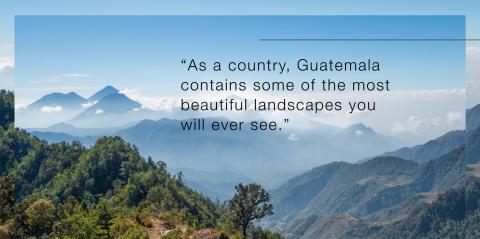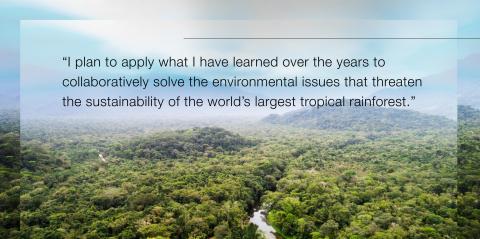
An avid reader and fervent cook, Africa Flores leads the Land Cover & Land Use Change Thematic Service Area for NASA’s SERVIR Science Coordination Office. From a young age, Africa had a passion for learning about the world around her—a passion she now shares with her two-year-old daughter, Adriana. Part of that innate curiosity means viewing the world around her from a different perspective.
“Satellite-derived observations, such as those provided by NASA and other agencies, are key to mapping and monitoring changes on the Earth's surface,” Africa says. “There is a common saying, ‘We cannot manage what we cannot measure.’”
Read on to learn how Africa’s upbringing inspired her path to NASA and her advice to young women looking to follow in her footsteps someday.

1. Where did you grow up?
I was born in Retalhuleu, Guatemala—Reu, for short. It is located in the southwest of the country, on the Pacific Coast, and is primarily an agricultural area. However, you could drive 45 minutes away and be in a completely different ecosystem. In fact, from my home in Reu I could see volcanoes. One active volcano called Santiaguito I saw smoking many times. As a country, Guatemala contains some of the most beautiful landscapes you will ever see. Believe me, there are no pictures or words eloquent enough to describe it. I think my childhood experiences had an impact on what I decided to study later in college. Seeing the biodiversity and natural richness of my country made me want to study something that could help me understand and manage those resources better.
2. How did you get involved with the NASA/USAID SERVIR program?
After college, I started working in Geographic Information Systems (GIS) at the National Council for Protected Areas in Guatemala. While at the Council, I helped collect and analyze data for environmental purposes and I worked closely with the Ministry of Environment and Natural Resources. The Environmental Ministries happened to be one of the main stakeholders of the SERVIR hub in Mesoamerica, and through my connection with the Ministry, I was introduced to the SERVIR team and joined them in Panama in 2008. After the Mesoamerica hub ceased operations, I began my work with the SERVIR hub in Eastern and Southern Africa, where I worked on a variety of projects, including land cover, water quality, frost mapping, and vulnerability mapping. I think what stands out the most to me was the experience of working with colleagues from another continent who had very similar environmental issues to those found in Latin America. I remember one project in particular where I had the incredible opportunity to advise Susan Malaso from Kenya—it was a very rewarding experience. Her work on frost mapping has become the backbone of the service that SERVIR Eastern and Southern Africa operates in Kenya.
3. Speaking of Africa, how did a young girl born in Guatemala end up named Africa?
My dad had already picked out my name even before I was born! He knew that when he had a daughter her name would be Africa Ixmucane. Africa because humanity comes from Africa, and Ixmucane, after a Mayan God who helped create humanity out of maize. He liked those two analogies together as a name for his future daughter.

4. What words of advice would you give a young girl growing up in Latin America who wants to follow in your footsteps?
“Don’t give up.” I would not be where I am today if I had succumbed to the many obstacles I faced due to my position, in terms of my gender and economic situation. My achievements were questioned and my drive for becoming a professional was mocked. People would even laugh at my clothes—the only ones I had. I would remind myself that my future was at stake, and Earth science was my chance to break the cycle of economic dependence that women are subjected to in developing nations like Guatemala. With the loving support and guidance of my mom, in particular, as well as my dad and two brothers, I was able to overcome these obstacles.

5. Soon you’ll be helping citizens in South America conserve and better manage their natural resources as the SERVIR-Amazonia Regional Science Coordination Lead. Are you excited to be closer to home?
I’m extremely happy to return to my roots and work in Latin America again. We will focus on the Amazonia region, with the main emphasis in Colombia, Peru and Brazil. I think there will be a lot of cross-collaboration with the other SERVIR hubs, and I plan to apply what I have learned over the years to collaboratively solve the environmental issues that threaten the sustainability of the world’s largest tropical rainforest.
On a more personal level, it means that I will be able to go back to the region that gave me the opportunity to become a professional. I feel it’s my responsibility to pay it forward wherever I work.


